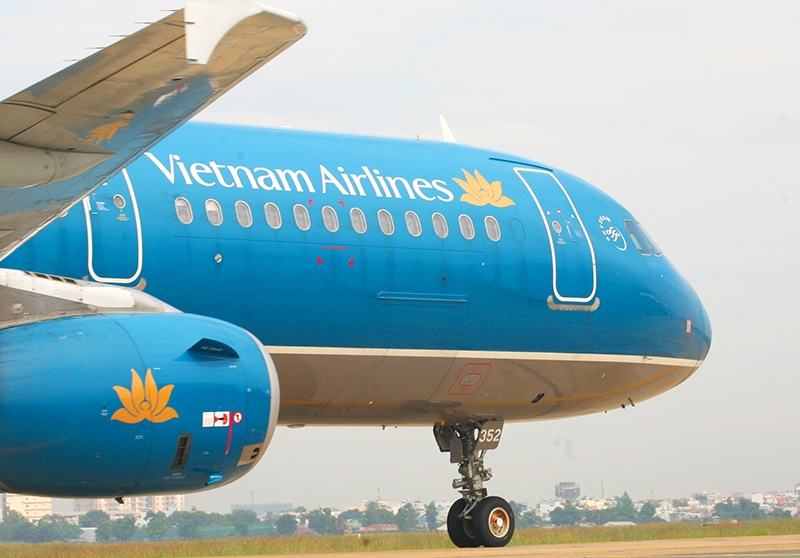Airlines push ahead with domestic flights
 |
| Vietnam Airlines and its rivals have had no choice but to focus on domestic travel Photo: Le Toan |
While cross-border flights remain all but stagnant, Vietnamese airlines have had no choice but to focus on the domestic market, in which Vietnam Airlines and Bamboo Airways have opened new routes. The moves will go a little way towards helping the airlines and the local economy get back on their feet.
National flag carrier Vietnam Airlines announced last week that it would open six more domestic routes this month, connecting the northern port city of Haiphong and destinations in central and southern Vietnam including Phu Quoc, Dalat, Can Tho, and Buon Ma Thuot.
The airlines started reopening domestic routes nationwide early last month, after approval from the government and the Civil Aviation Authority of Vietnam (CAAV). Since April 23, Vietnam Airlines has transported more than half a million passengers on domestic routes. Flights on routes connecting Hanoi and Ho Chi Minh City to Danang have seen 90 per cent of their seats filled.
Meanwhile Bamboo Airways, which started its first commercial flight in January last year, has commenced domestic flights but only at 50 per cent of pre-pandemic capacity. Before the coronavirus hit, it operated 150 domestic flights per day.
From June 1, Bamboo Airways has increased flight frequency mainly on the Hanoi-Ho Chi Minh City route, among others, to 80 flights per day, and will aim for 120 flights from June 15. The airline plans to increase flights to Vinh and Quy Nhon in anticipation of the summer season.
Vo Huy Cuong, deputy director of the CAAV, informed that a number of domestic routes have reached 80 per cent of capacity compared to the peak during the Lunar New Year festivities. Normally, the domestic market peaks during the summer season from May to July. This year, if the summer break for students is extended, the aviation industry may have an opportunity to rebound strongly.
After the pandemic began to subside in Vietnam, airlines quickly moved to launch promotional packages with products such as flight cards and combos with various unprecedented attractive incentives to stimulate the tourism industry.
From July 1, Vietnam will grant e-visa to citizens of 80 countries – a pre-planned move that confused many who assumed that meant resumption of access into the country from that date. However, the country will have to wait a little longer until other nations catch up with the remarkable success of Vietnam in controlling the coronavirus.
Still, enterprises in Vietnamese aviation stand ready to resume international flights. “Once other countries managed to control COVID-19 and remove entry restrictions and strict isolation requirements, we will resume international flights,” said the CAAV’s Cuong at a conference on aviation development held in the central coastal province of Binh Dinh last week. “To ensure safety, security, and service quality to our customers is our first concern.”
The Ministry of Transport recently requested the CAAV to submit a proposal on researching and reporting on the possibility of resuming international routes. The proposal will be submitted this week and forwarded to the prime minister for consideration and decision.
“Although there is not yet an exact time for the reopening of international routes, we are still seeking solutions to recover some international routes. We now maintain international cargo arrivals and departures but still limit the entry of passengers,” Cuong added.
Meanwhile, the International Civil Aviation Organization last week made predictions of expected opening times of some airports worldwide. As of May 31, over 70 countries and territories had set dates on attempting to open up international routes.
Many countries and territories will open their schedules in mid-June and at the latest early August, but uncertainties linger as governments fear second waves of COVID-19, or have to deal with other internal strifes. For example, alongside Vietnam, the United States has not decided official schedules for international flights, but September is being touted by some in the industry as a likely and hopeful time for the resumption of some cross-border routes.
While waiting for the correct time to bring new international flights, time will be taken to upgrade infrastructure. According to Airports Corporation of Vietnam (ACV), the number of aircraft taking off and landing in Noi Bai International Airport has been reduced by about 50 per cent compared to the start of the year. With that in mind, repair and upgrade of runways and taxiways is being accelerated, especially at Noi Bai and Tan Son Nhat airports. ACV revealed in March that it needs VND1.88 trillion ($81 million) to improve the infrastructure of Tan Son Nhat and VND2.28 trillion ($100 million) to improve the infrastructure of Noi Bai.
What the stars mean:
★ Poor ★ ★ Promising ★★★ Good ★★★★ Very good ★★★★★ Exceptional
Related Contents
Latest News
More News
- Vietjet resumes Con Dao flights from early December (November 28, 2025 | 15:24)
- Free tickets, Lunar New Year promotions on offer at Vietjet Mega Livestream (November 26, 2025 | 15:32)
- UNIQLO unveils upgraded heat-retention wear at Hanoi event (October 26, 2025 | 10:00)
- Vietnam named among world’s top four culinary destinations (October 24, 2025 | 17:09)
- Vietnam and Denmark strengthen dialogue on sustainable fashion (October 20, 2025 | 09:11)
- Fusion rolls out special initiatives to celebrate Vietnamese Women’s Day (October 17, 2025 | 20:00)
- Showcase AC 2025 set to light up Hanoi stage (September 12, 2025 | 18:06)
- Hotel Indigo Saigon The City hosts event to reimagine city’s beloved alleyways (July 23, 2025 | 17:04)
- UNIQLO’s sustainability strategy behind the brand's global growth (June 23, 2025 | 15:42)
- Vietnam International Travel Mart 2025 kicks-off in Hanoi (April 10, 2025 | 17:50)

 Tag:
Tag:





















 Mobile Version
Mobile Version